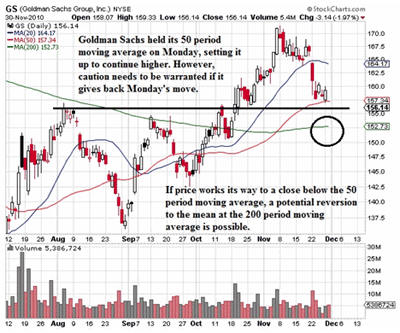Goldman Sachs (GS) is offering two interesting trading set-ups that option traders could use, each of which has a different directional bias. The daily chart places Goldman in a descending channel and provides traders who want to get short with defined risk. Those who remain bullish could get long and use the 50-period moving average as a stop. At this stage in the December option expiration cycle, utilizing time decay (Theta) as either a profit engine or a way to reduce the cost of a spread is a sound trading strategy.
With less than three weeks until expiration, time decay (Theta) accelerates rapidly on its inevitable path to zero at expiration. This process increases dramatically the final two weeks leading up to expiration. Option traders that utilize time decay (Theta) to reduce the cost of a spread or as the primary profit engine of a trade construction (credit trades) are capitalizing on an inevitability.
Clearly there are inherent risks such as an increase in implied volatility, but without question, at option expiration, the time value of options will be reduced to zero. Time decay (Theta) and implied volatility are the two most likely culprits as to why novice option traders consistently lose money when trading options. Understanding a few basic principles regarding option Greeks is critical in order to produce profits. The daily chart of Goldman Sachs is shown below.
Those who are bullish with regard to Goldman Sachs could use a call vertical (bull call spread) with the following strikes:
Long 1 December 160 call contract
Short 1 December 165 call contract
Through the use of a hard stop well below the 50-period moving average, an option trader could define his risk while having a quality risk/reward trade. The maximum loss on this trade would be less than $180 per leg, while the maximum gain would be slightly over $320, not including commissions, as of Wednesday morning. The use of a hard stop would reduce risk further and could potentially lead to a nice profit in the days to come.
For traders who want to press the downside, a put vertical (bear put spread) could be used with a contingent stop around the $161-per-share price level. The trading set-up is as follows:
Long 1 December 160 put contract
Short 1 December 155 put contract
The maximum loss per side for this trade would be around $230, while the maximum gain is $270 as of the Wednesday morning. Similarly to the call vertical spread listed above, the use of the contingent stop reduces the intraday risk even further. While these set-ups are about as basic as it gets regarding option trading, they can really produce some nice profits. Again, these are not recommendations, but simply an example of the profitability that options can add to your trading if they are used appropriately.
In closing, we are seeing a lot of head-and-shoulders patterns developing in a variety of trading vehicles. While these patterns can mean substantial downside is ahead, there is always the potential that they could fail. Failed patterns result in fast, potentially devastating moves. If the head-and-shoulders patterns we are seeing in the S&P 500, gold, and oil fail, a fast-paced rally will likely unfold. In contrast, if the patterns play out, a nasty selloff could take place. At this point in time, a significant move is likely to unfold, but as usual, which direction prices will eventually go remains unknown.
By J.W. Jones of OptionsTradingSignals.com





















